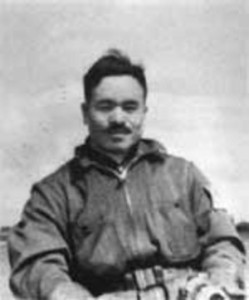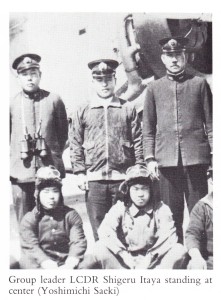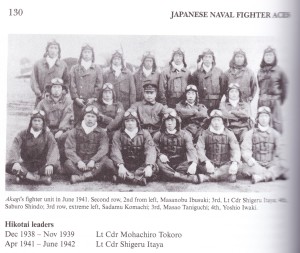I had been contemplating doing a series on the A6M Zero, the Japanese Imperial Navy’s legendary fighter, for quite some time. However, I found the task daunting as there were several different versions of the Zero and, by my count, 15 different manufacturers who have tried their hand at producing prebuilt 1/72 scale models of Japan’s iconic fighter. Together, they have released more than 50 prebuilt Zeros in 1/72 scale. A6M2s, A6M3s, A6M5s, clipped wings, floatplanes, carrier-based, land-based — I was completely at a loss about where to begin. Then I had an epiphany: Start at the Beginning — literally.
The United States entered WWII following the Japanese attack on Pearl Harbor. That attack occurred in two waves of aircraft taking off from Japanese carriers, each wave comprising Zero fighters, torpedo bombers, and dive bombers. In each wave, the Zeros were the first airborne, both because they needed the least runway to take off and in order to protect the slower, less maneuverable torpedo and dive bombers that followed. The pilot who led the Zeros in the first wave and the first to take off from a Japanese carrier was Shigeru Itaya, flying his A6M2 off the flagship carrier Akagi. Thus, one can reasonably argue that Itaya’s Zero was the first Japanese aircraft to take an aggressive action against the United States, in essence beginning the Pacific War.
Shigeru Itaya
This site is dedicated to 1/72 scale models and presumes general knowledge of WWII on the part of the reader. Thus, I’m ordinarily reticent to regurgitate historical information, as there are plenty of sources on the internet accessible to any reader. If I can readily find information, so can others.  However, I found such precious little information on Lieutenant Commander Shigeru Itaya, other than the oft-repeated fact that his Zero was the first plane airborne during the attack on Pearl Harbor, that I reasoned some readers would be interested in my amateur research. I found scant references to him in the books available to me and the dearth of information extended to the internet, where, despite diligent efforts, a search yielded only dribs and drabs of information.
However, I found such precious little information on Lieutenant Commander Shigeru Itaya, other than the oft-repeated fact that his Zero was the first plane airborne during the attack on Pearl Harbor, that I reasoned some readers would be interested in my amateur research. I found scant references to him in the books available to me and the dearth of information extended to the internet, where, despite diligent efforts, a search yielded only dribs and drabs of information.
On a hunch that Itaya might be better known in Japan, I searched Japanese sites and stumbled upon Japanese Wikipedia, where I found that Itaya had his own entry. Unfortunately, the entry was skeletal, with not much more information than that available in English. Still, it was more information than I had. Bearing in mind that I know no Japanese and had to resort to imperfect searches on Japanese websites using Google Translate, below is what little information I could gather from various sources. Itaya’s career highlights may prove somewhat tedious so the casual reader may want to skip to the next post, a review of the 1/72 scale models of Itaya’s Zero.
1. Beginnings
Itaya was born July 10, 1909, and graduated from the Naval Academy in 1929. He was a veteran of the China War and by 1937 is listed as a division officer on the Ryujo aircraft carrier. By 1940, he is listed as group leader on the Hiryu aircraft carrier. By April 1941, Lieutenant Commander Itaya had been named group leader on the Akagi, the flagship of the Japanese Imperial Navy’s First Fleet.
2. Pearl Harbor
According to Jim Rearden in Cracking the Zero Mystery, Itaya himself trained the Zero pilots for the Pearl Harbor raid. He was in overall command of the 43 Zero fighters in the first wave from all six carriers, including the nine from the Akagi, Itaya’s carrier. He was the first to take off, guiding the other 42 Zeros to their destination. Once in Hawaii, Itaya and the eight other pilots of the Akagi attacked Hickam Field, Ewa Air Control, and Ford Island, while the Zeros of the five other carriers had different assigned targets. According to Peter Smith in Mitsubishi Zero, Itaya and his two wingmen shot down an unsuspecting B-17 bomber at Hickam Field that had at that precise moment improvidentially flown in from California. The B-17 crew managed to land the crippled bomber and run for cover, though one unfortunate member was killed in the ensuing strafing by the Japanese Zeros.
3. Port Darwin
Two months later, on February 19, 1941, in an aerial surprise attack that has been called Australia’s “Pearl Harbor,” Itaya led the 36 Zero fighters — nine from each of four carriers — in the bombing of Port Darwin, according to Peter Smith in Mitsubishi Zero. Considered the single most destructive raid in Australian history by a foreign power, the raid on Port Darwin was massive, with more bombs dropped than at Pearl Harbor, though loss of life — at 236 — was one tenth that at Pearl Harbor. Incidentally, the four carriers at Port Darwin had all participated at Pearl Harbor and were the same four subsequently sunk at Midway.
4. Ceylon
Itaya appears again on April 5, 1942, during the surprise “Easter Sunday Raid” on Colombo, Ceylon (now Sri Lanka). As at Pearl Harbor and Port Darwin, Itaya led Zero fighters — this time 36 — that escorted bombers from five Japanese carriers whose targets were British warships, harbor installations, and air bases in an attempt to destroy the British Easter Fleet. Although the day before a PBY Catalina pilot spotted the five Japanese carriers and radioed in their position before it was shot down, the Japanese still achieved surprise in yet another Pearl Harbor-style weekend attack. The attack resulted in the sinking of a British carrier and several other warships and cost the lives of 424 British subjects. However, as at Pearl Harbor, most of the British Eastern Fleet was away from the port, thereby reducing potential damage.
5. Midway
Volumes have been written about the Battle of Midway in June 1942 and anyone reading this is likely familiar with the battle. Thus, I will not repeat that information here. Suffice it to say that, according to Peter Smith in Mitsubishi Zero, Itaya once again was in charge of all the Zero fighters at Midway and, in particular, led the attack on the 15 ill-fated TBD Devastators from the USS Hornet, killing 29 men (only Ensign George Gay survived). Once the Akagi was sunk, its pilots ditched their planes near other Japanese warships and Itaya and others pilots were rescued by the escorting ships.
6. Staff Officer
My admittedly faulty understanding of the Google translation of the Japanese Wikipedia indicates that Itaya became chief of staff for 23 Air Corps in October 1942 and chief of staff of 54 Air Corps in July 1944. Despite checking the indices of numerous books, I found no information on Itaya covering the two-year period between those two appointments. However, logic indicates that like many other highly skilled veteran pilots who survived Midway, he would have been used by the Japanese Navy to train the thousands of new pilots required to restore the staggering losses suffered during Midway and elsewhere as the tide turned against Japan. Still, if anyone has more information, please post a comment.
7. Kuril Islands
On July 24, 1944, just after his 35th birthday, while flying on a Mitsubishi G3M aircraft in the Kuril Islands, Itaya’s plane was accidentally shot down by friendly fire. Although his death is listed as an accident on lists of WWII Japanese pilots, it’s unclear to me whether he was shot down by ground anti-aircraft fire or by a Japanese Army plane. Either way, the G3M bomber went down and Itaya was killed in the crash. It is an interesting coincidence and perhaps a fitting end that a man who had dedicated his entire career to serving Admiral Isoroku Yamamoto, the Commander-in-Chief of the Combined Fleet of the Imperial Japanese Navy, who was killed when his G4M aircraft was shot down, would meet his fate the same way.
8. Was Itaya an Ace?
I found a couple of references on the internet stating that Itaya had made ace during the China War but these statements were unsourced. On the other hand, I could not find Itaya on the lists of Japanese aces I consulted, including Osprey’s Imperial Japanese Navy Aces 1937-45 by Henry Sakaida and Stackpole’s Japanese Naval Fighter Aces: 1932-45 by Ikuhiko Hata et al. It is something of a conundrum that a fighter pilot who graduated from the Naval Academy in 1929 and died in 1944 would have failed to shoot down five planes during his 15-year career, particularly since Itaya was presumably a highly skilled pilot, as evidenced by his position and rank. It is even more perplexing when one considers that from 1937 to 1944 he witnessed seven years of continuous combat firsthand. Furthermore, Itaya would have had many opportunities available during the early years of the Sino-Japanese War, when the Zero reigned supreme over the inferior Russian-made aircraft used by the Chinese, and during the Battle of Midway, where 150 American aircraft were shot down. Perhaps more information will surface in the future that will confirm his status one way or the other.
9. Conclusion
To summarize, the highlights of Itaya’s career parallel that of the Akagi. The Akagi’s victories were essentially Itaya’s victories and the Akagi’s bitter loss at Midway effectively ended Itaya’s career as a pilot. While it is ironic that a pilot who survived countless aerial encounters was ultimately shot down by friendly fire, it is hardly surprising that Itaya did not survive the war, for only a handful of the elite Japanese Zero pilots at Pearl Harbor managed to do so. What is surprising is that there is no evidence that Itaya made ace during his 15-year career as a pilot during one of the most tumultuous and target-rich periods in aerial warfare.
Below are two lagniappe group photos from the Hiryu and Akagi aircraft carriers. The photo at left is from Itaya’s time on the Hiryu, scanned from Hata et al’s Japanese Naval Aces and Fighter Units (1989 version translated by Don Gorham). The photo at right is from Itaya’s time on the Akagi, scanned from Hata et al’s Japanese Naval Fighter Aces (2011 version translated by Christopher Shores). The content and photos of the two versions of Hata et al’s book differ somewhat.
Again, thank you for your indulgence. I hope you enjoyed the post, or at least found it informative. I will continue to update this post as I come across more information or photos on Itaya. If something looks amiss, please let me know. I would be delighted to correct inaccurate information so that this may be useful for other 1/72 scale collectors and wargamers. As always, comments, questions, corrections, and observations are welcome, particularly in this case where so little information on Itaya is available. Please stay tuned for reviews of prebuilt 1/72 scale models of Itaya’s Zero in the next three posts.




Jonathan says:
Thank you for your work! It is very informative! I can now dedicate the Zero aircraft model I am currently building to Lt. Cmdr. Shigeru Itaya as a veteran of both Pearl Harbor and Midway battles.
Again, thank you and I truly appreciate your research.
Jonathan says:
Wonderful work here, thank you! Using it for some reference on doing my 1/144 Itaya’s Zero from Sweet.
A polite and humble heads up/correction: Adm Yamamoto went down in a G4M, Allied Code Name “Betty,” not a G3M “Nell.”
chules says:
Jonathan,
Thank you so much for your comment and for visiting the website. You are absolutely right that the aircraft in which Admiral Yamamoto met his fate was a G4M — not a G3M. I’ve corrected the post. It’s amazing that I missed it as Donald Davis’ Lightning Strike on Operation Vengeance, the mission to kill Admiral Yamamoto, is one of my favorite books.
Best regards,
chules
Jonathan says:
chules,
No worries! Nice to see another fan of Christopher Shores. His Grub Street publishing books have been indispensable in my own studies.
Please continue your wonderful work, I’ve favorited the site!
Kyle says:
More information about the Battle of Midway available at http://ww2history.net/the-battle-of-midway/
Also if you wish to read more about the Zero and its’ variants http://ww2history.net/japanese-planes/mitsubishi-a6m-zero/
J Mollison says:
Hey.
Interesting research regarding LtCdr Shigeru Itaya.
I’m working on a Midway project…do you have any more documentation on the man (and specifically) his aircraft?
chules says:
Hi John,
Thanks for visiting the site. Unfortunately, I have no other information on Itaya. I included everything I could find in this post. As far as I know, there are no photos of Itaya’s plane, though color profiles by modern military artists abound, including my favorite one, which is in the post that follows this one. If you find anything, please come back and post a comment.
Thanks and regards,
chules